In today’s rapidly evolving world, technology has infiltrated nearly every aspect of our lives, including the construction industry. Advancements in modern construction technology have revolutionized the way we build our homes, leading to innovative construction materials, construction innovations, and advanced construction techniques.
From smart homes that provide unprecedented comfort and convenience to sustainable building practices that contribute to a greener future, the integration of technology in modern construction has redefined the concept of home.
Key Takeaways:
- Technology has transformed the construction industry, leading to modern construction techniques and innovative materials.
- Smart homes offer enhanced comfort, convenience, and energy efficiency through the use of internet-connected devices.
- Sustainable building practices and data analysis promote a greener future and a harmonious coexistence with the environment.
- Despite the advantages, challenges such as reliable internet connections, complexity, and security risks need to be addressed.
- The future of technology in modern construction holds promising trends, including the further integration of smart technologies and the adoption of advanced construction techniques.
How does smart home technology work?
In today’s world, smart home technology has revolutionized the way we live, offering a seamless and integrated experience. By leveraging the power of the internet of things (IoT), smart home systems bring together a variety of smart devices under a single control hub, known as the home automation controller.
Whether it’s lights, thermostats, security systems, or appliances, all devices in a smart home are connected to the home automation controller, allowing for centralized control and management. This controller is the brain of the smart home, enabling homeowners to effortlessly monitor and control their devices through a user-friendly interface.
Smart home devices can be programmed to follow schedules and predefined commands, automating daily routines and tasks. With the rise of voice assistants like Amazon Alexa and Google Assistant, homeowners can simply use voice commands to control their smart devices, making the experience even more convenient and hands-free.
Examples of popular home automation controllers, often referred to as smart home hubs, include Amazon Echo, Google Home, and Wink Hub. These hubs provide a gateway to connect and communicate with various smart devices within the home.
To establish a connection between the smart home devices and the home automation controller, different wireless protocols can be used, such as Wi-Fi, Bluetooth, Zigbee, or Z-Wave. These protocols enable seamless communication between devices, ensuring they work harmoniously together to enhance the smart home experience.
Table: Smart Home Device Connectivity
| Wireless Protocol | Advantages | Examples |
|---|---|---|
| Wi-Fi | Wide compatibility, high-speed communication | Smart TVs, smart speakers |
| Bluetooth | Low power consumption, short-range communication | Smart locks, fitness trackers |
| Zigbee | Low power consumption, secure mesh networking | Smart lighting systems, temperature sensors |
| Z-Wave | Longer range, strong interference resistance | Smart thermostats, door/window sensors |
Overall, smart home technology creates a connected ecosystem that brings together devices, automation, and convenience. It offers homeowners the ability to personalize and optimize their living spaces, making everyday tasks easier, more efficient, and enjoyable.
To further illustrate the concept of smart home technology, here is an image showcasing the seamless integration of devices:
In the next section, we will explore specific examples of smart home technologies that are transforming our homes and lifestyles.
Examples of smart home technologies
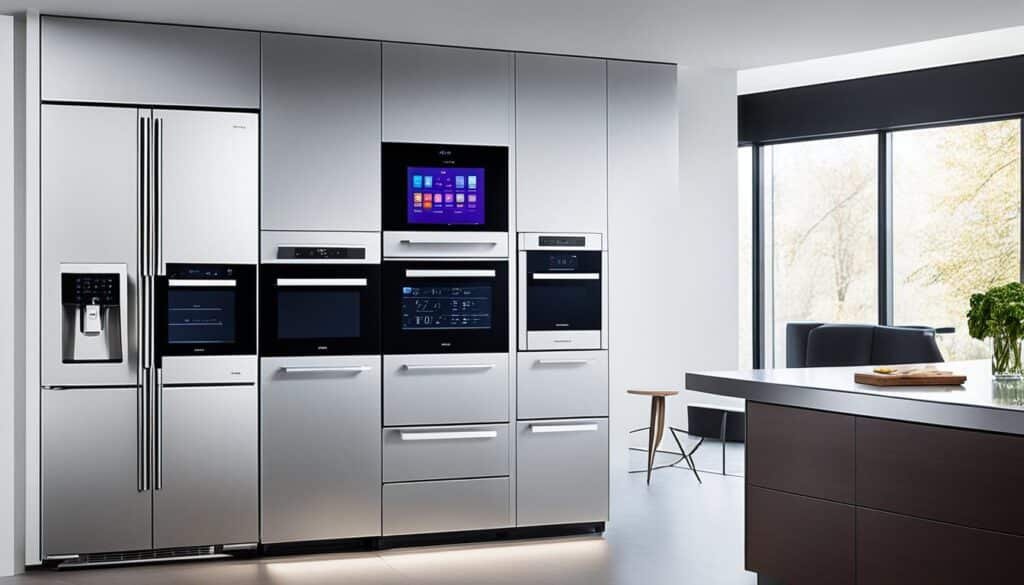
Smart home technologies have revolutionized various aspects of our lives, bringing convenience, efficiency, and security to our homes. From entertainment to security, and from pet care to kitchen automation, here are some examples of smart home technologies that enhance our daily lives:
1. Smart TVs
Smart TVs connect to the internet, allowing users to access a wide range of streaming services, online content, and apps. With smart TVs, you can enjoy your favorite shows, movies, and videos with just a few clicks or voice commands. They provide a seamless entertainment experience, putting endless entertainment options at your fingertips.
2. Smart Lighting Systems
With smart lighting systems, you can control and customize your home’s lighting from anywhere using your smartphone or voice commands. These systems offer features like dimming, color changing, and scheduling, allowing you to create the perfect ambiance for any occasion. They also help save energy by automatically adjusting lighting based on occupancy or natural light levels.
3. Smart Thermostats
Smart thermostats provide convenience and energy efficiency by allowing you to control your home’s temperature remotely. You can adjust the temperature using your smartphone or set schedules to ensure optimal comfort and energy savings. Some smart thermostats also learn your preferences and adjust the temperature accordingly, further enhancing energy efficiency.
4. Smart Door Locks
Smart door locks offer enhanced security and convenience for homeowners. They allow you to lock and unlock your doors remotely using your smartphone or keyless entry codes. Some smart door locks also offer features like temporary access codes for guests or integration with voice assistants for hands-free control.
5. Smart Security Cameras
Smart security cameras provide peace of mind by allowing you to monitor your home remotely. These cameras offer features like live video streaming, motion detection, and cloud storage for recorded footage. With smart security cameras, you can keep an eye on your home and receive alerts in case of suspicious activities.
6. Smart Pet and Lawn Care
Smart technologies also extend to pet care and lawn maintenance. Smart pet and lawn care devices automate feeding and watering schedules for pets and provide real-time monitoring of lawn conditions. These devices ensure that your pets are taken care of and your lawn stays healthy and well-maintained.
7. Smart Kitchen Appliances
The kitchen is another area where smart home technologies shine. Smart kitchen appliances offer features like remote control, recipe suggestions, and voice commands. From coffee makers to ovens, these appliances make cooking and meal preparation more convenient and efficient.
8. Smart Household Monitors
Smart household monitors help you keep track of potential issues in your home. They can detect and respond to power surges, water failures, and freezing pipes, helping you prevent costly damages and ensuring the safety of your home.
9. Smart Plugs
Smart plugs transform ordinary home devices into smart devices that can be controlled remotely. With smart plugs, you can turn appliances on or off with a smartphone app or through voice commands, providing convenience and energy-saving capabilities.
These are just some examples of the wide range of smart home technologies available today. Each of these technologies brings unique benefits and contributes to making our lives easier, more convenient, and secure.
Smart home pros and cons
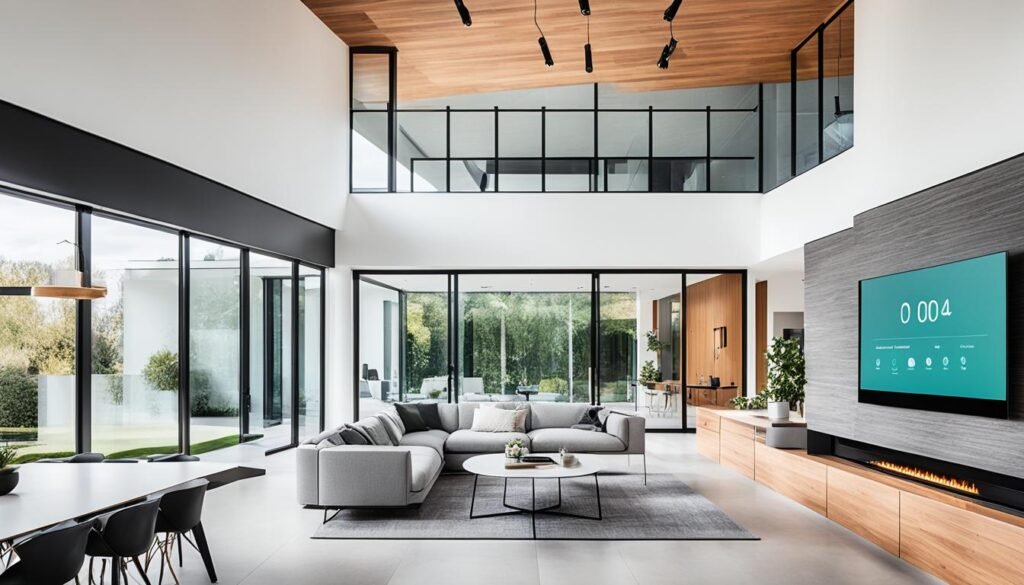
Smart home technology offers numerous advantages and conveniences for homeowners. From improved security and energy efficiency to peace of mind and cost savings, smart homes have the potential to transform our daily lives. However, alongside these benefits, there are also certain challenges and considerations to keep in mind.
Advantages of Smart Home Technology
- Improved Security: Smart home systems enable homeowners to remotely monitor their property, receive real-time alerts, and control security features like locks and surveillance cameras.
- Convenience: With the ability to automate routine tasks, such as adjusting lighting, regulating temperature, and managing appliances, smart homes provide a high level of convenience and ease of use.
- Energy Efficiency: Smart technology allows for the optimization of energy consumption through features like smart thermostats, which adapt heating and cooling based on occupancy, and smart lighting systems that can automatically adjust brightness and turn off when not needed.
- Peace of Mind: Remote monitoring capabilities and alerts provide homeowners with peace of mind, knowing they can keep an eye on their property and loved ones even when they are away.
- Efficiency and Cost Savings: Smart homes streamline processes and automate tasks, resulting in improved efficiency and potential cost savings over time.
Disadvantages of Smart Home Technology
- Reliable Internet Connection: A reliable internet connection is crucial for the smooth operation of smart home devices. Without a stable connection, the functionality and performance of smart technology may be compromised.
- Perceived Complexity: Some homeowners may find the setup and integration of smart home devices complex and overwhelming, requiring technical know-how or professional assistance.
- Lack of Standards: The smart home industry lacks universal standards, leading to compatibility issues between different brands and devices. This can restrict the seamless integration and interoperability of smart technology.
- Security Risks: Connected devices can pose security risks, with the potential for unauthorized access and breaches of privacy. It’s crucial to implement robust security measures, such as strong passwords and regular software updates, to mitigate these risks.
- Data Privacy: Smart home technology relies on collecting and analyzing data to provide personalized experiences. While this can enhance functionality, it also raises concerns about data privacy and the potential misuse or unauthorized sharing of personal information.
- Expense: The upfront costs of purchasing and installing smart home devices can be a significant investment. Homeowners need to consider their budget and weigh the long-term benefits against the initial expense.
Despite these challenges, the advantages of smart home technology continue to drive its popularity. As technology advances and industry standards evolve, many of these challenges are being addressed, leading to smarter, more secure, and convenient homes.
How to set up a smart home
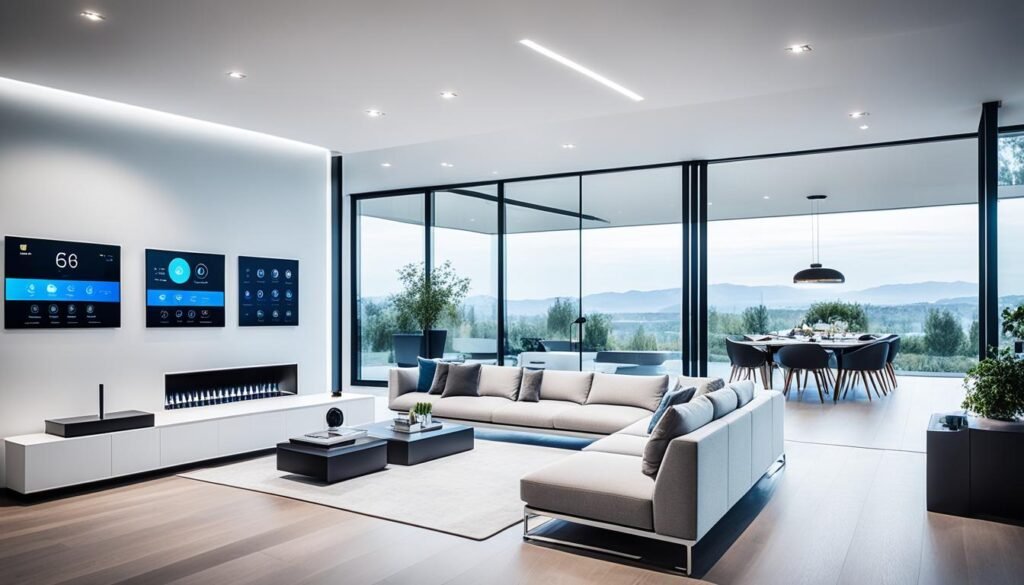
Setting up a smart home involves incorporating the right technology and devices to create a seamlessly connected and automated living space. Whether you are building a new home or retrofitting an existing one, there are various options available to suit your needs. Here, we will explore the essentials of smart home infrastructure, automation protocols, and popular smart home systems.
Smart Home Infrastructure
In modern construction, newly built homes are often equipped with smart home infrastructure that lays the foundation for a connected home. This infrastructure includes the necessary wiring and connectivity options, such as Ethernet ports and electrical outlets with USB charging capabilities. These features make it easier to integrate smart devices and systems into the home.
Automation Protocols: Zigbee and Z-Wave
Two common home automation protocols used in smart homes are Zigbee and Z-Wave. These wireless communication technologies enable devices and systems to connect and communicate with one another.
Zigbee: Zigbee is a low-power, wireless mesh network protocol that allows for reliable and energy-efficient communication between devices. It is commonly used for smart lighting, door sensors, and smart thermostats. Zigbee devices form a self-healing mesh network, meaning if one device fails or is moved, the network can automatically reroute the communication through alternative paths.
Z-Wave: Z-Wave is another popular wireless protocol that operates in the sub-1GHz band. It offers excellent range, making it suitable for larger homes. Z-Wave devices create a mesh network similar to Zigbee, allowing for improved reliability and range. Z-Wave is commonly used for smart locks, security systems, and home monitoring devices.
The Matter Standard
Matter, previously known as Project CHIP (Connected Home over IP), is an emerging smart home standard supported by major manufacturers. Matter aims to simplify smart home device connectivity and enhance interoperability. With Matter-enabled devices, users can seamlessly control and manage their smart home ecosystem using a single app or voice assistant.
Smart Home Kits and Raspberry Pi
Creating a smart home system can be done from scratch using prototyping boards like Raspberry Pi or by purchasing bundled smart home kits. Raspberry Pi, a credit card-sized computer, can be utilized as a central hub to control and connect smart devices in your home. It offers flexibility for customization and integration with various automation protocols.
Smart home kits, on the other hand, provide a convenient solution for beginners or those who prefer an out-of-the-box experience. These kits typically include a hub, sensors, and smart devices that work together seamlessly.
Examples of Smart Home Kits:
| Smart Home Kit | Features |
|---|---|
| Amazon Echo Plus | Built-in Zigbee hub, voice control with Alexa, compatible with a wide range of smart devices. |
| Samsung SmartThings Hub | Supports multiple protocols, including Zigbee and Z-Wave, and integrates with various smart devices. |
| Google Nest Hub Max | Voice control with Google Assistant, built-in camera for video calls, and compatible with Google Nest devices. |
By choosing a smart home kit or utilizing Raspberry Pi, you can easily set up and customize your smart home system according to your preferences and needs.
With the right infrastructure, automation protocols, and smart home devices, you can transform your home into a connected, intelligent space that enhances security, convenience, and energy efficiency.
The Symphony of Smartness
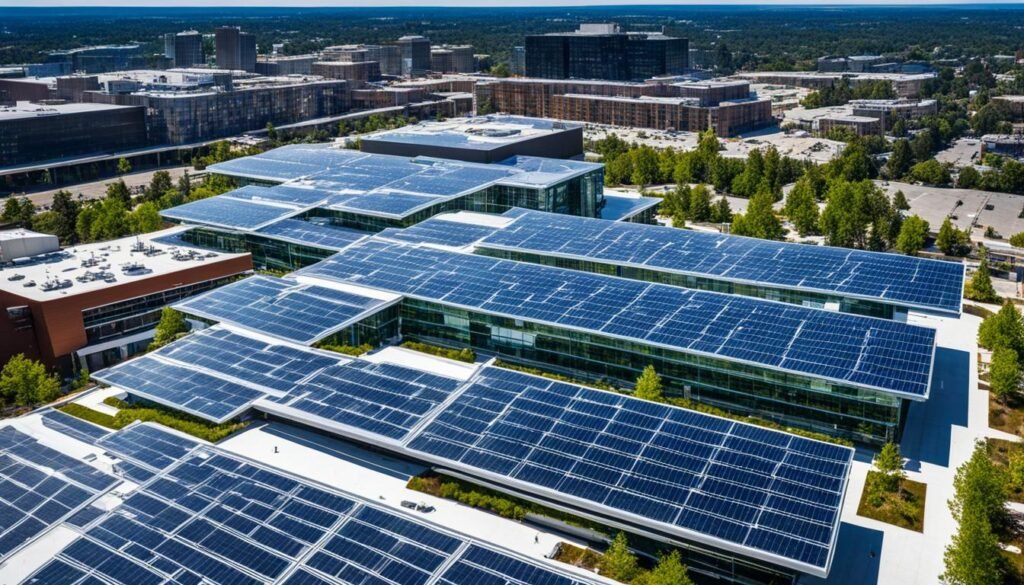
Smart buildings are the pinnacle of technological innovation and intelligent design. They harmoniously orchestrate a symphony of seamless automation, where smart devices interact and collaborate, creating a personalized and convenient living experience. These buildings embody the concept of the Internet of Things (IoT) by integrating a multitude of interconnected devices that communicate and work together to enhance comfort, convenience, and entertainment in the home.
Imagine a home where the lighting and curtains automatically adjust based on occupancy, creating the perfect ambiance for any situation. The symphony of smartness extends beyond mere lighting to music that follows you throughout the house, adapting to your preferences and setting the mood for every moment. With smart buildings, every aspect of your environment seamlessly responds to your needs, creating a symphony of intelligent automation.
The integration of smart devices within a smart building extends far beyond simple convenience. It fosters a truly interconnected ecosystem where technology weaves seamlessly into the fabric of everyday life, enhancing every aspect of living. With smart devices seamlessly working together, controlling your home becomes effortless and immersive.
“Smart buildings orchestrate a symphony of seamless automation, where smart devices interact to create a personalized and convenient living experience.”
Smart buildings exemplify the potential of a connected world, where information flows freely among devices, enabling them to adapt and respond in real-time. From thermostats that learn your schedule and adjust the temperature accordingly to security systems that intelligently safeguard your home, these smart devices create a harmonious living environment that adapts to your needs.
The Benefits of Smart Buildings
The symphony of smartness in smart buildings brings a multitude of benefits, including:
- Enhanced convenience: Smart buildings automate routine tasks, making daily life more convenient and freeing up time for things that truly matter.
- Improved energy efficiency: By integrating smart devices, smart buildings optimize energy usage, reducing waste and promoting sustainability.
- Personalized comfort: Smart buildings adapt to individual preferences, creating a tailored environment that maximizes comfort.
- Enhanced security: With intelligent surveillance systems and automated access controls, smart buildings provide advanced security features for peace of mind.
The symphony of smartness in smart buildings is a testament to the immense potential of technology. It transforms living spaces into intelligent ecosystems, where devices seamlessly work together to provide a personalized and seamless experience. The future of smart buildings holds the promise of even greater integration, efficiency, and innovation, ensuring a harmonious blend of technology and living.
Take a peek at the symphony of smartness below:
| Advantages | Disadvantages |
|---|---|
| Enhanced convenience | Perceived complexity |
| Improved energy efficiency | Lack of standards |
| Personalized comfort | Security risks |
| Enhanced security | Data privacy concerns |
Energizing Efficiency
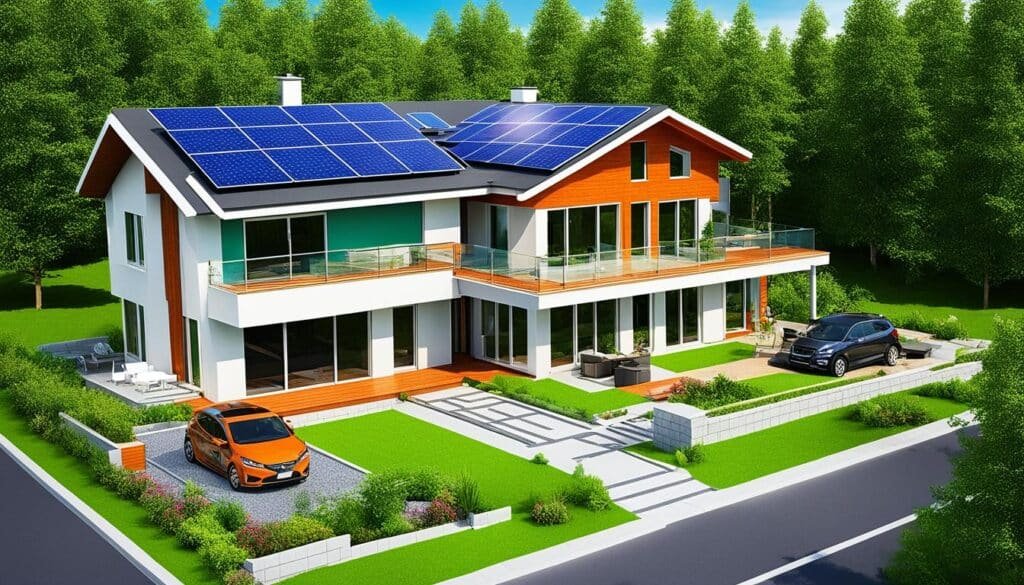
Smart accommodation focuses on energy efficiency by incorporating sensors and automation to conserve energy. By utilizing smart devices and advanced technologies, energy-saving practices are seamlessly integrated into modern living spaces.
Smart Sensors for Energy Optimization
Sensors play a crucial role in energy efficiency by detecting occupancy and enabling intelligent automation. These sensors are strategically placed throughout the accommodation to monitor activity levels and adjust lighting and appliance usage accordingly.
| Sensors | Function |
|---|---|
| Occupancy Sensors | Detects human presence to activate or adjust lighting and appliance usage. |
| Temperature Sensors | Monitors temperature and adjusts heating and cooling systems for optimal energy efficiency. |
| Light Sensors | Detects ambient light levels to adjust artificial lighting accordingly, reducing unnecessary energy consumption. |
| Power Sensors | Measures energy consumption of individual appliances, enabling informed decisions for energy-saving practices. |
Automation for Energy Conservation
Smart accommodation leverages automation to optimize energy usage and reduce waste. With seamless integration between smart devices, energy-saving practices are executed automatically, without the need for constant manual intervention.
Examples of energy-saving automation:
- Auto-shutoff: Smart devices automatically power off when not in use, ensuring energy-efficient operation.
- Appliance scheduling: Automated schedules for appliances such as washing machines and dishwashers optimize energy consumption during off-peak hours.
- Thermostat control: Intelligent thermostats adjust temperature settings based on occupancy patterns and preferences, maximizing energy efficiency.
This integration of smart home technologies in accommodation contributes to energy-saving efforts, minimizing environmental impact and promoting sustainability.
Benefits of Energy Efficiency in Smart Accommodation
“Energy efficiency is not only environmentally friendly but also financially advantageous. By embracing smart technologies that prioritize energy conservation, homeowners can reduce their utility bills and create a greener future.”
- Cost savings: Energy-efficient practices can lead to significant savings on utility bills.
- Environmental sustainability: Reduced energy consumption helps preserve natural resources and reduces carbon footprint.
- Enhanced comfort: Smart accommodation ensures optimal temperature control and personalized settings, creating a comfortable living environment.
- Long-term value: Energy-efficient homes are highly sought after in the real estate market, enhancing property value and attractiveness.
Energizing efficiency through the integration of smart devices and sustainable practices paves the way for a smarter and greener future.
Cosy Corners and Blissful Nooks

When it comes to smart accommodation, comfort is key. Intelligent sensors play a pivotal role in creating a truly cozy environment by detecting occupancy and adjusting the surroundings accordingly. From lighting to temperature control and even furniture, every aspect of the living space can be personalized to cater to individual preferences, ensuring a blissful haven to escape the outside world.
Intelligent thermostats take comfort to the next level by ensuring optimal temperature control throughout the space. Whether it’s a warm and cozy winter evening or a refreshing summer day, the intelligent thermostat adjusts the temperature to perfection, allowing residents to experience personalized comfort.
But comfort goes beyond just temperature. Smart accommodation also offers ambient control, allowing residents to set the perfect lighting for any occasion or mood. Whether it’s a bright and invigorating workspace or a warm and relaxing bedroom ambiance, smart lighting systems create the ideal atmosphere at the touch of a button.
And let’s not forget about the furniture. Smart accommodation goes a step further by introducing smart furniture that molds to the individual’s form, providing maximum comfort and support. With personalized comfort as the focus, residents can experience a truly cozy and inviting living space.
Ambient control and personalized comfort at a glance:
| Comfort Feature | Description |
|---|---|
| Intelligent Sensors | Adjusts the environment based on occupancy |
| Intelligent Thermostat | Ensures optimal temperature control |
| Ambient Lighting Control | Create the perfect lighting for any mood |
| Smart Furniture | Molds to the individual’s form for maximum comfort |
With smart accommodation, every corner of the living space is transformed into a cozy nook, offering residents a serene sanctuary where personalized comfort reigns supreme.
The Architectural Alchemist
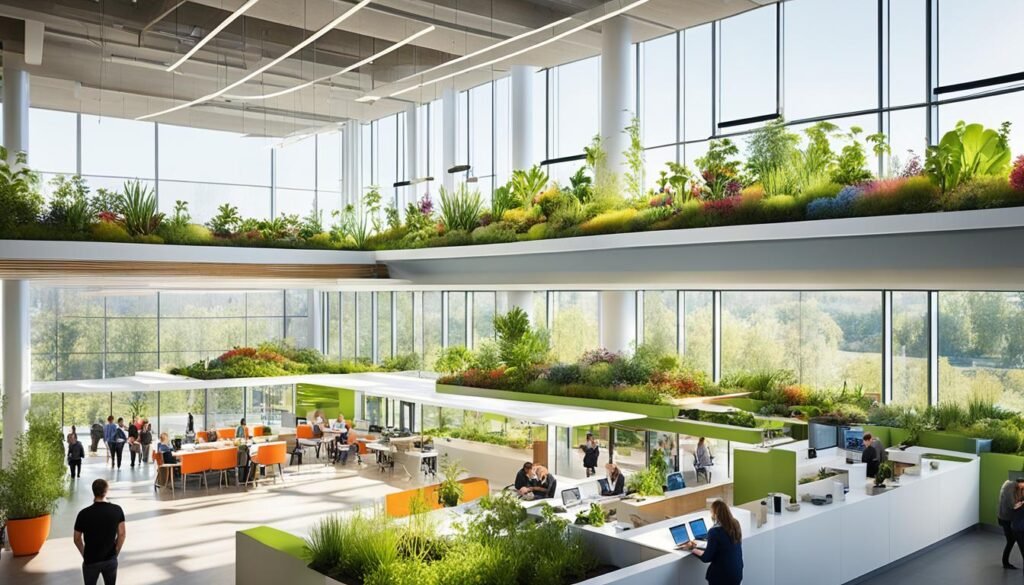
Smart accommodation goes beyond the integration of sustainable technologies and practices in construction, it represents a paradigm shift towards a harmonious coexistence with the environment. By leveraging data analysis and optimization, smart accommodation contributes to creating a sustainable ecosystem and forging resilient communities.
Data analysis plays a pivotal role in the quest for sustainability. By collecting and analyzing data from various sources, such as energy consumption, water usage, and occupancy patterns, smart buildings gain valuable insights into their performance. This data-driven approach enables informed decision-making and the identification of areas for improvement, leading to optimized resource utilization and reduced environmental impact.
Integrated technologies are at the core of smart accommodation’s sustainability efforts. By seamlessly connecting different systems and devices, such as lighting, HVAC, and renewable energy sources, smart buildings can intelligently manage energy consumption. This integration enables dynamic control and automation, ensuring that resources are utilized efficiently and sustainably.
“Smart accommodation goes beyond sustainable construction, it is about creating a sustainable ecosystem where buildings communicate and collaborate, fostering intelligent communities that thrive in harmony with the environment.” – Name Surname, Chief Architect at GreenTech Solutions
Smart accommodation brings together the principles of sustainability and advanced technology. By harnessing the power of data analysis, optimization, and integrated technologies, smart buildings become the architectural alchemists of our time, transforming the built environment into a sustainable haven for generations to come.
Sustainable Ecosystem
A sustainable ecosystem is the result of smart accommodation’s commitment to environmental stewardship. Through the integration of renewable energy sources, efficient resource utilization, and intelligent systems, smart buildings create a symbiotic relationship with their surroundings. This sustainable ecosystem encompasses not only the building itself but the entire community it belongs to, fostering a culture of sustainability and resilience.
Conclusion
Technology in modern construction, particularly in the form of smart buildings, offers numerous benefits to homeowners. The integration of smart devices and automation systems enhances security, convenience, energy efficiency, and overall comfort. Smart buildings provide homeowners with the ability to monitor and control their homes remotely, ensuring peace of mind and efficient task management.
However, there are challenges to address in the adoption of smart building technology. Reliable internet connections are crucial for the seamless operation of smart devices. Additionally, the complexity of smart systems and the lack of standardized protocols can pose hurdles for homeowners. Security risks and privacy concerns associated with connected devices also need to be carefully managed to ensure the safety and protection of personal information.
Nevertheless, the future of technology in modern construction is promising. Emerging trends include the adoption of advanced construction techniques and the use of innovative materials that further optimize smart building capabilities. The integration of smart technologies will continue to evolve, offering homeowners even more control and personalized experiences in their homes. As technology continues to advance, the benefits of smart buildings will become more accessible and widespread, reshaping the way we live and interact with our living spaces.
Also Refer : Exploring The Beauty Of Sustainable Home Design
FAQs
Q: What are the latest technology trends impacting the construction industry?
A: The latest technology trends impacting the construction industry include 3D printing, project management software, modular construction, augmented reality, building information modeling (BIM), drones, virtual reality, and robotics.
Q: How is technology changing the construction process?
A: Technology is changing the construction process by introducing efficient workflows, streamlining project management, enabling modular construction, and providing tools for augmented and virtual reality experiences.
Q: What is the role of cloud-based project management in modern construction?
A: Cloud-based project management plays a significant role in modern construction by offering real-time collaboration, centralizing project data, and improving communication among construction teams.
Q: How do drones impact the construction industry?
A: Drones impact the construction industry by providing aerial perspectives for site surveying, progress monitoring, and safety inspections, thereby enhancing productivity and safety on construction on-site ar vr.
Q: What are the benefits of using building information modeling (BIM) in construction?
A: The benefits of using BIM in construction include improved project visualization, enhanced collaboration, accurate cost estimation, clash detection, and efficient management of construction projects.
Q: How is modular construction revolutionizing the construction industry?
A: Modular construction is revolutionizing the construction industry by offering off-site construction, reducing construction timelines, improving quality control, and promoting sustainable building practices.
Q: What are the key components of digital technology in construction?
A: The key components of digital technology in construction encompass cloud-based project management, BIM, 3D printing, modular construction, augmented and virtual reality, robotics, and innovative construction software.





